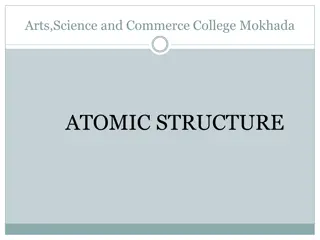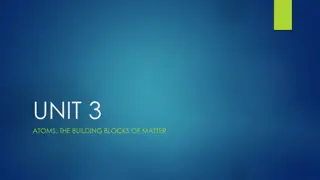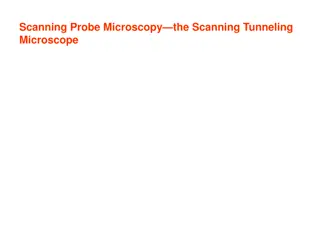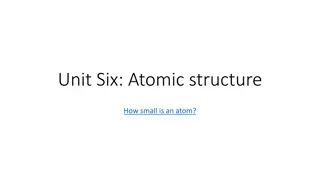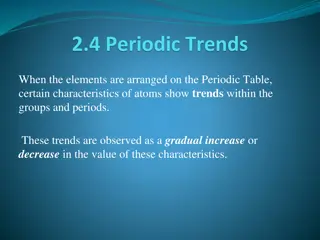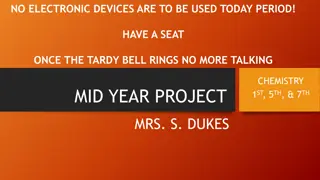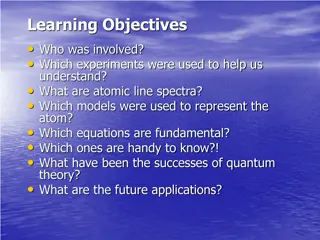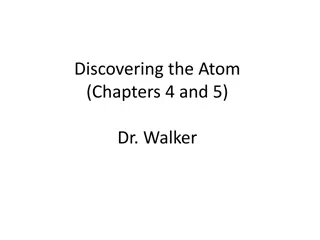Exploring the Evolution of Atomic Theory
Delve into the historical journey of atomic theory starting from Democritus and Aristotle's views to modern advancements proving some aspects of Dalton's theory incorrect. Learn about key laws and theories such as the Particle Theory of Matter, Dalton's Atomic Theory, and JJ Thomson's discoveries, shaping our understanding of the building blocks of matter.
Download Presentation

Please find below an Image/Link to download the presentation.
The content on the website is provided AS IS for your information and personal use only. It may not be sold, licensed, or shared on other websites without obtaining consent from the author. Download presentation by click this link. If you encounter any issues during the download, it is possible that the publisher has removed the file from their server.
E N D
Presentation Transcript
Unit 3 ATOMS: THE BUILDING BLOCKS OF MATTER
In your notes Draw a model of an atom that best represents each component of that atom.
Foundations of Atomic Theory Particle Theory of Matter Democritus in 400 B.C. Stated that nature s basic particle was the atom ( indivisible in Greek). Aristotle Believed all matter was continuous (could be divided forever), and did not believe in atoms. Neither had experimental evidence to support their claims.
Fast Forward to the18thcentury Three laws discovered due to improved instrumentation and carefully observed chemical reactions Law of conservation of mass Mass is neither created nor destroyed during an ordinary chemical reaction or physical change. Law of definite proportions A chemical compound contains the same elements in exactly the same proportions by mass regardless of the size of the sample or source of the compound. Example: Table salt will always consist of 39.34 % Na and 60.66% Cl. Law of multiple proportions If 2 or more compounds are composed of the same two elements, the ratio of the masses of the second element combined with a certain mass of the first element is always a ratio of small whole numbers. Example: Carbon and Oxygen can combine to form CO2 or CO.
Daltons Atomic Theory John Dalton proposed Atomic Theory Accounted for all three laws: conservation of mass, definite proportions, and multiple proportions. Dalton s Atomic Theory consists of the following statements: All matter is composed of atoms. Atoms of a given element are identical in size, mass, and all other properties. Atoms cannot be subdivided, created, or destroyed. Atoms of different elements combine in simple whole-number ratios to form chemical compounds. In chemical reactions, atoms are separated, combined, or rearranged.
Modern Atomic Theory Advances in instrumentation have allowed some aspects of Dalton s theory to be proven incorrect. Example: The thoughts that atoms are not divisible into smaller particles and have the exact same mass are incorrect. The two most important aspects of Dalton s theory still hold true All matter is composed of atoms. Atoms of any one element differ in properties than atoms of another element.
JJ Thomson, 1900 Discovered the charge to mass ratio for the electron Concluded that the electron has a very large charge- to-mass ratio Conducted Cathode-ray experiments to prove that atoms are divisible. Proposed plum pudding model for the atom. http://www.youtube.com/watch?v=2xKZRpAs WL8
Milikan and the oil drop experiment Meaured mass of droplets Applied charge to droplets through x-rays. Applied electric voltage to top and bottom plates Measured the amount of voltage it took to keep the oil droplets suspended. Was able to measure the charge of a single electron!
Ernest Rutherford Discovered the nucleus of an atom with his gold-foil experiment. http://www.youtube.com/watch?v=XBqHkraf8iE Concluded that the volume of the nucleus was very small compared to the total volume of the atom.
Section 2 COUNTING ATOMS
Atomic Number The number of protons in each atom of a given element Unique to each element and does not change Used to identify elements.
Practice 1. How many protons and electrons are in each atom? Radon Titanium 2. An atom of an element contains 66 electrons. Which element is it? 3. An atom of an element contains 14 protons. Which element is it?
Isotopes and Mass Number The amount of protons and electrons are constant in all neutral atoms of an element, but the number of neutrons can vary Isotopes atoms of the same element that have different numbers of neutrons Example: Hydrogen atoms have three different isotopes. Protium 1 proton/0 neutrons (accounts for 99.985% of all hydrogen atoms). Deuterium 1 proton/1 neutrons (0.015%) Tritium 1 proton/2 neutrons (radioactive, and can be produced artificially) Most elements contain mixtures of isotopes. Tin (Sn) has 10 stable isotopes, the most of any element. Mass Number--The number of protons and neutrons that make up the nucleus of an isotope. Since electrons are so small, their mass is considered insignificant.
Designating Isotopes Isotopes are usually identified by their mass number. Two Methods: Hyphen notation has hyphen after name of element, followed by the mass number. Example: Tritium is hydrogen-3 since it has 2 neutrons and 1 proton. Example: Uranium-235 Nuclear symbol Mass number written as superscript Atomic number written as subscript Followed by element symbol
In both methods The number of neutrons is found by subtracting the atomic number from the mass number. Example: Uranium-235 or 23592U (Mass #) (Atomic #) = (# of neutrons) 235 (protons + neutrons) 92 protons= 143 neutrons
Notation Practice 1. Determine the number of protons, neutrons, and electrons in each of the following: Neon-22 Iron-57 1. 2. ???? 3. 3. ?? 2. Write each of the following in hyphen notation: p = 12 n = 14 e = 12 p = 28 n = 25 e = 28 3. Write each of the following in nuclear symbol notation: p = 38 n = 39 e = 38 p = 4 n = 4 e = 4 1. 2. 1. 2.
Relative Atomic Masses Masses of subatomic particles = very tiny, so Scientists created a new unit Atomic mass units (amu) based on a standard of carbon-12 that has a mass of 12 amu Neutron 1.008665 amu Proton 1.007276 amu Electron 0.0005486 amu Important to note that the masses are slightly different between protons and neutrons.
Average Atomic Mass Avg. atomic mass the weighted average of the masses of the isotopes of that element Avg. atomic mass = (mass x abundance)isotope1 + (mass x abundance)isotope2+ To find abundance divide the percentage by 100 (all abundances must be decimals) Atomic mass can help you determine which isotopes of that element is the most abundant.
Atomic Mass Practice Nitrogen has two naturally occurring isotopes, N-14 and N-15. Its atomic mass is 14.007. Which isotope is more abundant? Explain. 1.
Calculate the average atomic mass of lithium, which occurs as two isotopes that have the following atomic masses and abundances in nature: 6.017 amu, 7.30% and 7.018 amu, 92.70%.
Recall What is the atomic mass of hafnium if, out of every 100 atoms, 5 have a mass of 176, 19 have a mass of 177, 27 have a mass of 178, 14 have a mass of 179, and 35 have a mass of 180.0? Iodine is 80% 127I, 17% 126I, and 3% 128I. Calculate the average atomic mass of iodine.
Relating Mass to Number of Atoms The Mole (mol) Same as 1 dozen = 12 donuts Mole = SI unit for amount of substance. The amount of substance that contains as many particles as there are atoms in exactly 12 g of carbon-12. Avogadro s number The number of particles in exactly 1 mol of a pure substance. 6.022 1023 atoms in 1 mol of any substance.
Practice How many atoms are in 5.76 moles of a pure substance? How many moles are in 8.56 1026 atoms?
Molar Mass The mass (in grams) of 1 mol of a pure substance. Units are g/mol Equal to the sum of the atomic masses of each element of a compound. Examples: K2CO3 Cu(NO3)2
Find the molar masses of the following compounds: SrCO3 C13H18O2 Sn2(SO4)4
Gram/Mole Conversions Use molar mass to convert moles to grams and vice versa. Practice: Convert 7.00 g of He to moles. Convert 5.67 mol of Xe to grams. Convert 65.4 g of K2CO3 to mol. Convert 5.21 mmol of NaCl to grams.
Mass to Number of Atoms/Molecules Need 2 conversion factors!!! Always go through moles. 1. How many atoms are contained in 4.33 g of Br2? 2. What mass of carbon contains exactly 2.10x1024 atoms?
Finding atoms of mass of one element in a compound Subscripts are mole ratios! In order to change substances, you must go through moles first!! Determine the mass of iron in 4.32 g of Fe2O3
More Practice How many atoms of sodium are in 4.56 g of Na2CO3? What mass of oxygen is in 5.91 g of phosphate?






